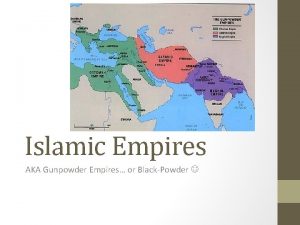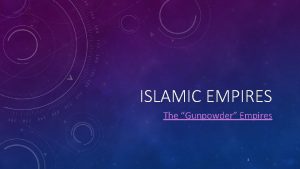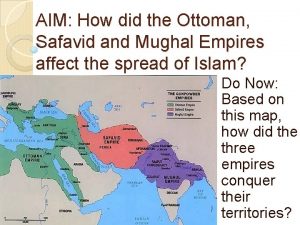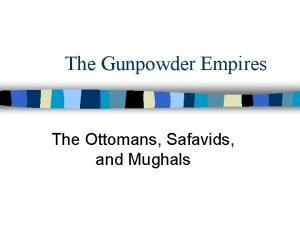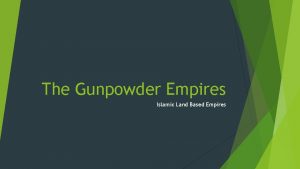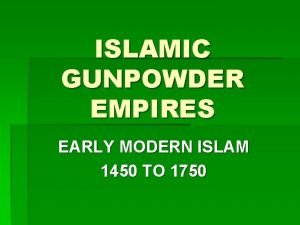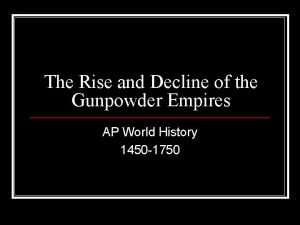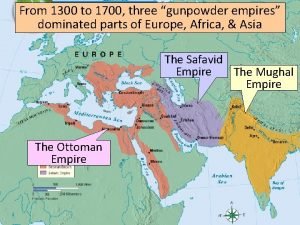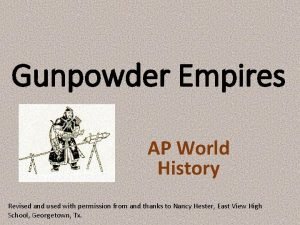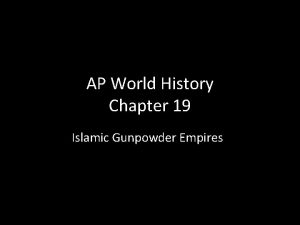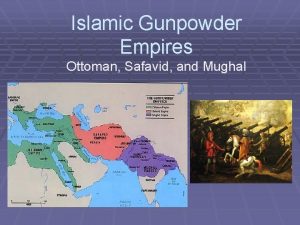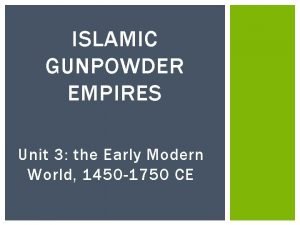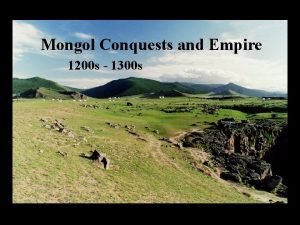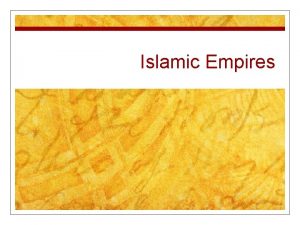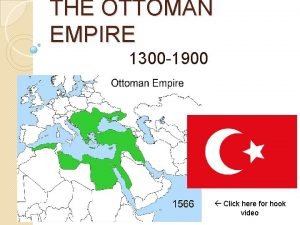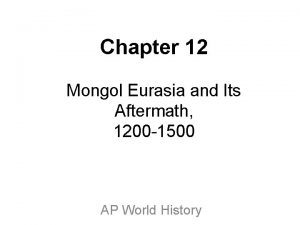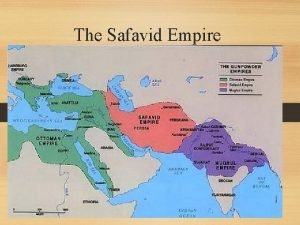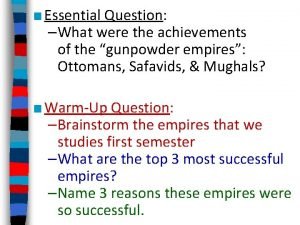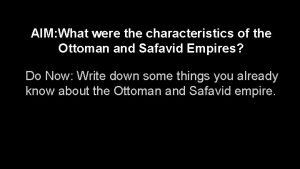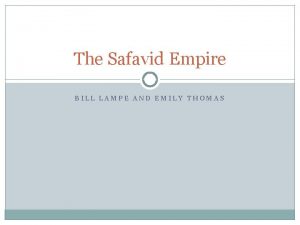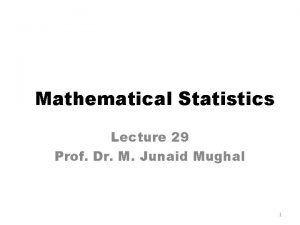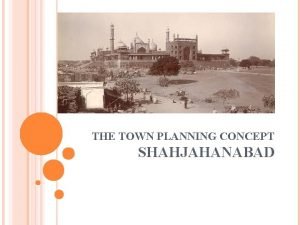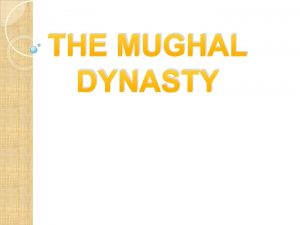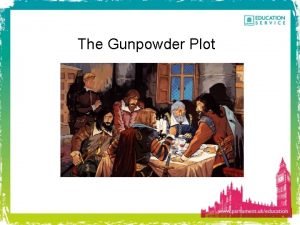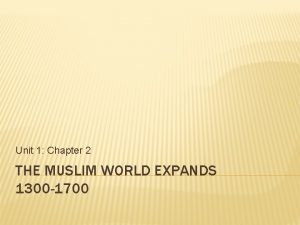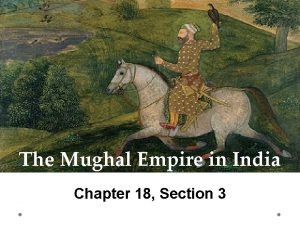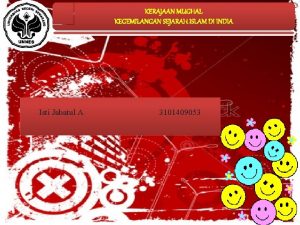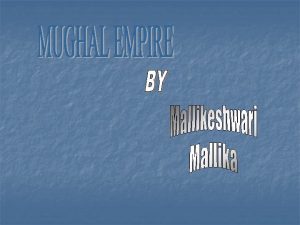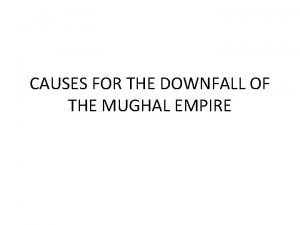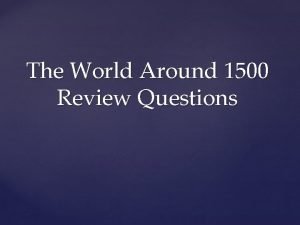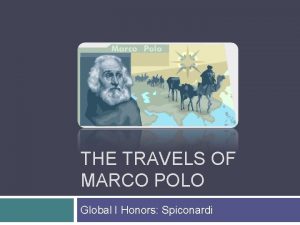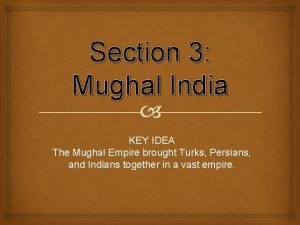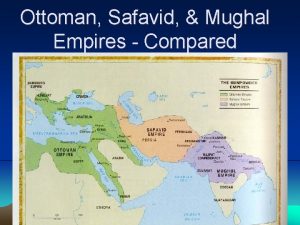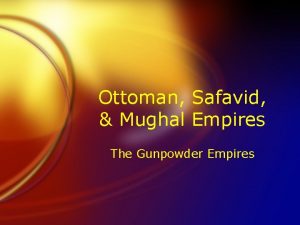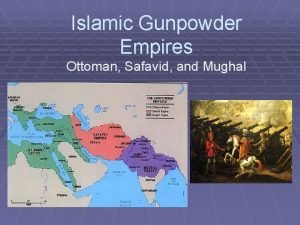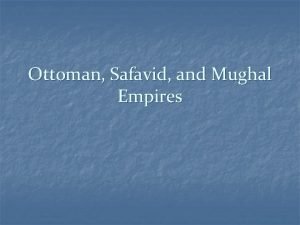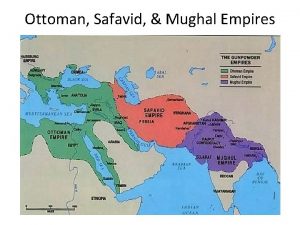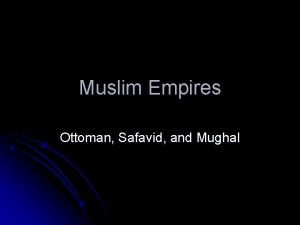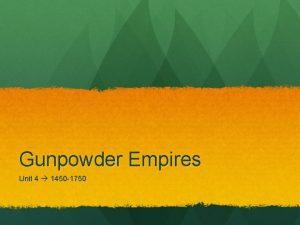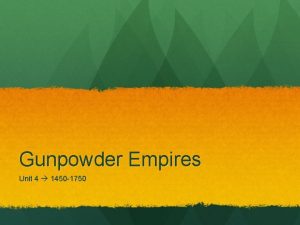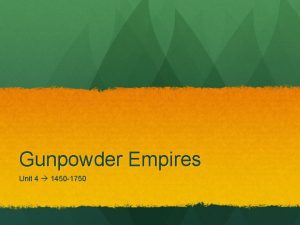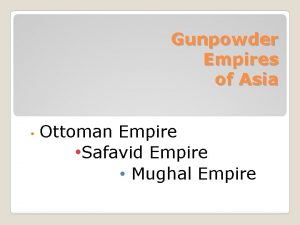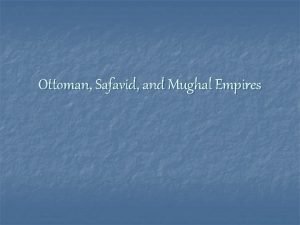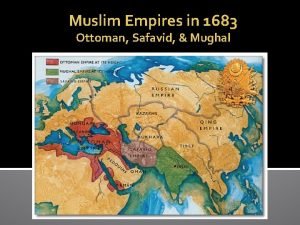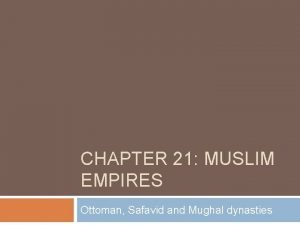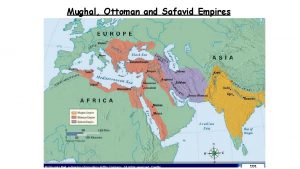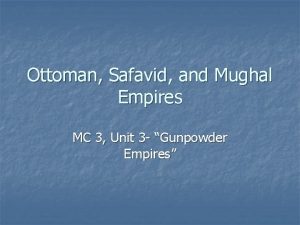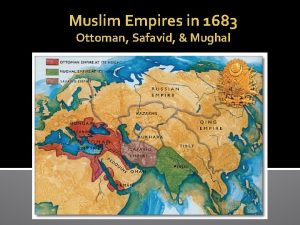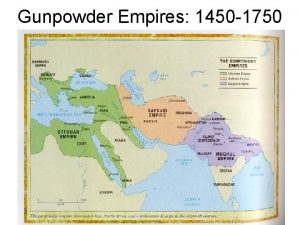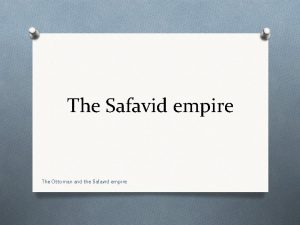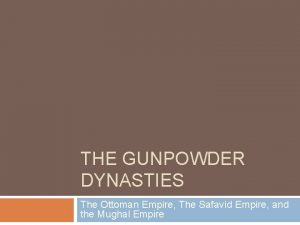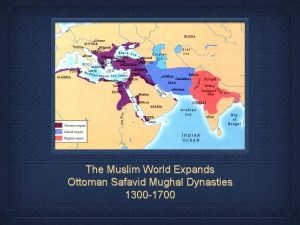The Gunpowder Empires Ottoman Safavid Mughal Ottoman Origins


















































- Slides: 50

The Gunpowder Empires: Ottoman, Safavid, Mughal

Ottoman Origins • One of many Muslim warrior groups on East frontier of Byzantine Empire • Conquered much of western Anatolia & Balkan Peninsula • Most long lived of post-Mongol empires

Ottoman: Turning Point • 1453, broke through massive walls & captured Constantinople • Renamed Istanbul • Gave Turks control of city that symbolized Christian teachings & connection to ancient Rome • Strategic location for long-distance trade & military deployments

Ottomans: 1516 -1517 • Selim took title of caliph, defender of faith • extended from Black Sea to Red Sea to Strait of Gibraltar • little impact on N. Africa • Pashas, appointed government officials, collected taxes and maintained law & order reported to sultan in Constantinople

Ottoman Expansion • Soldiers and sailors continued to push borders outward • Sultans established administrative rule that compared favorably with regimes elsewhere • Distinctive use of different type of slavery • Based on religion, not skin color • Called Devshirme

Ottoman: Suleiman I • 1520 • expanded Ottoman rule into Europe and West Med. Sea • ruled for 46 years • great military commander, known for legislation as well • codified Ottoman law-kept Islamic faith • Tolerance for Christians of the Empire • addressed taxes • built more schools

Ottomans • Suleiman married harem girl from Poland named Roxelana-had 5 children with her • executed his eldest son, Mustafa, because Roxelana said he was planning to kill Suleiman and take power – her son Selim took power when Suleiman died in 1566

Ottomans • success largely based on mastery of firearm technology • Sultans head of empire • supreme political & military authority • Power always transferred to single authority • position of sultan was hereditary – son always succeeded father

Ottomans • Since time of Mehmet II, sultans ruled from the Topkaki Palace in Istanbul • administrative headquarters & chief residence of sultan • private domain of sultan called “harem, ” or “sacred place” • Sultans often chose 4 wives as favorites • When son became sultan, his mother became queen mother - acted as a major adviser to throne

Ottoman Centralized Power • Chief advisor was “Grand Vizier” • Led meetings of imperial council - met 4 days a week • Sultan sat behind screenmade wishes known to GV • Empire divided into districts-ruled by officials who were helped by bureaucrats trained at palace schools • Senior officials given land - collected taxes & supplied armies

Ottomans • Sunni • Sultans claimed title of caliph • responsible for guiding & keeping Islamic law • In practice, they gave their religious duties to the “ulema” - a group of religious advisors • Ulema were responsible for legal system & schools for educating Muslims

Ottomans • Tolerant of non-Muslims • Non-Muslims paid tax, but allowed to practice their religion & could convert to Islam • Most people in European areas remained Christian • In some areas, large numbers converted to Islam

Ottomans & Portuguese Threat • In early 16 th century, merchants form south India & Sumatra requested help from Ottomans • Ottomans responded vigorously to threat close to their territory • did not see growing threat of world wide naval powers like Portuguese • Never formulated a consistent aggressive policy in Indian Ocean to counter growing European dominance • Trapped in land based paradigm when world was shifting to naval power

Ottoman: Devshrime (Child Levy) • Christian boys taken by force from families • Placed w/Turks • Converted to Islam • Trained for service in one of four royal institutions – Palace – Scribes – Religious – Military

Ottoman Institutions: Janissary Corps • By 1520’s, military balanced between cavalry archers and Janissaries-Christian prisoners forced to serve as military slaves • Standing army-lived in barracks and trained all year • Willing to fight on foot with guns

Ottoman Military • Muslim states relied on slave soldiers for long time • Conquest of Christian lands provided new military source • Converted to Islam • Provided flexibility-willing to fight on foot with guns • Ottoman were horse culture-guns too heavy and awkward on horseback

Ottoman Navy • Manned by Greek, Turkish, Algerian, Tunisian sailors with N. African admirals • Turning Point: Lost battle of Lepanto against Venice, Spain, Papal States in 1571 -dispelled idea of Ottoman invincibility • Despite loss, their resources were so extensive that within a year, replaced all galleys that were sunk

Ottoman Society: • Cosmopolitan, sophisticated • Shari’a Law • Sultan – provided justice The Askeri – Professionals/Military Elites provided security • • The Raya Professionals Merchants-exempt from taxes Tradesmen Guild Members Peasants Non-Muslims-local customs and religious leaders provided structure and guidance

Ottoman: Crisis and Revolt 1585 -1650 Cannon & lighter-weight firearms gained importance Size/cost of Janissary grew Role of traditional cavalry diminished Sultan reduced number of landholding cavalrymen Revenue that used to go to their expenses, went into imperial treasury • Inflation from cheap silver from New World bankrupted many landholders who were restricted to fixed amount of taxes • Land returned to the state • Displaced cavalrymen, armed and unhappy, became a restive element • • •

Ottoman Crisis and Revolt • Revolts between 1590 -1610 • Marauders/Bandits • Former landholding cavalrymen, short-term soldiers • Overburdened peasants • Impoverished students • Anatolia suffered the worst • Government inability to stop spread of guns

Ottoman Janissary Privilege • Janissaries forced changes that helped the state in short run: • Could support themselves • Hereditary • Forced recruitment abolished • Total number of Janissaries increased, effectiveness as military force decreased

Ottoman Economic Changes: Tax Farming • Sultans became more isolated • Grand Viziers had real power • Tax farmers paid specific taxes in advance in return for collecting a greater amount from taxpayers • Rural administration disrupted • Tax farmers less likely to live on land • State had greater administrative burden to maintain order • Relied on provincial governors & on wealthy who purchased lifelong tax collection rights

Ottoman Growing Weakness • Demographic changes, Ottoman inability to control trade, growing dominance of European traders in Indian Ocean turned Izmir into multicultural entrepot • Agricultural economy of lands most accessible to Europe became enmeshed in growing European commercial networks • Ottoman security weakened

Ottoman Weakness • • • Military power decline Janissaries sometime hired replacements Sultans relied on poorly trained seasonal recruits 2 nd Seige of Vienna failed in 1683 Weakness obvious to Austrians and Russians Safavid empire collapsed in 1722

Ottoman Weakness • began w/ Selim II about 1699 • training of officials declined • senior positions given to sons/daughters of elite, based less on merit • elite only interested in own fortunes, so local government grew more corrupt and taxes rose • Wars depleted imperial treasury

Ottoman Weakness • Declining trade w/East as Safavid instability cut into Silk production • Taxes on coffee were higher to Muslim merchants 15% vs 3% • Europe dominated sea trade but did not gain control of Ottoman territory

Ottoman Weakness: The Tulip Period • Very few able to perceive downward spiral of Ottoman power & reasons for it • Ironically, elites became fascinated with European styles & attitudes • “Tulip Bulb” craze= growing detachment/ disengagement from real issues

Weakness: Patrona Halil Rebellion • 1730, a revolt by Janissary with religious overtones forced the abdication of Sultan Ahmed II • Halil took control but was executed • Confirmed that central government weak • Local powers gained power

Safavid Empire: 1501 -1722

Safavid Origins • Safavid Dynasty started w/ Shah Ismail • descendant of Safi al-Din-leader of Turkish ethnic groups in Azerbaijan near Caspian Sea • Under Ismail, Safavid took control of much of Iran & Iraq • Relied on cavalry paid through land grants • Multi-lingual • Oriented inward-not towards the sea

Safavids • Ismail called himself “shah, ” or king, of new Persian state • Ismail was Shiite • Theocracy • Created distinct Shi’ite identity • sent preachers to different areas to convert members of Ottoman Empire • led to massacre of Sunni Muslims when he took Baghdad • Ismail lost at Tabriz to Suleiman over religious differences

Safavid: Shah Abbas, 1588 -1629 • Restless, decisive, ruthless, intelligent, disciplined • brought Safavids to highest point of glory • Standardized Shiite beliefsbrought into line with Shari’a law • usurped throne from father & imprisoned him • later killed man who helped him gain throne • With European allies, attacked Ottoman Turks to regain lost lands

Safavid: Shah Abbas I • Enlarged Iranian territory • Stabilizing force after period of civil war and foreign invasions • Established global trade contacts between Asia and Europe • Built Isfahan • Donated generously • Employed calligraphers, painters, bookbinders, designers for inscriptions on buildings • Created a visual style that would be associated with his reign • Laid foundation for Modern Iran

Safavid Empire: Shah Abbas I • When he took power, Ottomans occupied West Iran, the Caucasus, and Iraq • Uzbeks controlled Khurasanincluding holy shrine of Imam Riza at Mashad • Regained territory with slave army of ghulams, Christian slaves who had converted • Seized Hormuz from Portuguese • Defeated Ottomans, regained Baghdad-allowed access to holy Shi’ite sites • Controlled trade in Persian Gulf

Safavids: Shad Abbas and Sufism • Mystical strain of Islam found in both Sunni and Shi’a sects • Also known as dervishes • Achieve oneness w/ god though prayer, rituals, visions- retreat from material world • Shah Abbas was Sufi & tolerant but would repress unorthodox Sufi beliefs or practices or if his authority was threatened

Safavids • Safavid Empire went from Azerbaijan on Caspian Sea east to India; along the Persian Gulf and Arabian Sea north to the southern border of Russia • When Shah Abbas died, religious orthodoxy increased • Women forced to give up freedom for life of seclusionwearing veil • Not cut off from outside world • Wife retained property after marriage-gave some women a stake in general economy and a degree of independence • Under Shari’a women could testify for themselves

Safavid Religion • • • Shi’ite Beliefs united Safavid Created further estrangement from neighbors-all Sunni Persian language 2 nd after Arabic Developed unique cultural elements in tile mosaics, poetry Shi’ite doctrine says that all temporal leaders are stand-ins for the “Hidden Imam”; the 12 th descendent of Ali Debate over the relationship between religion & politics led to religious scholars independent from imperial authority-did not become subordinate government functionaries like in Ottoman Empire

Safavid: Isfahan • Isfahan-jewel of Safavid Empire • Silk & carpet weaving flourished • Riza-i-Abbasi most famous artist of the time • beautiful works about simple subjects such as oxen plowing, hunters, and lovers • soft colors and flowing movement in painting

Safavid: Economy • Silks and carpets were important commercial goods • Good location on trade routes • Became rich from growing trade between Europe and Central Asia and India • Both Muslim and Non. Muslim traders • Most subjects were farmers/herders

Safavid: Economic Crisis and Political Collapse • Most subjects were subsistence farmers • no significant technological developments • Could not generate enough money for military and bureaucracy • Inflation from cheap silver from New World • Mismanagement of silk industry • Nomadic groups withdrew support • Afghan marauders captured Isfahan and ended Safavid rule •

Mughal Empire: 1605 -1707 • Babur founderunited Hindu & Muslim kingdoms • descendant of Mongol Conqueror Timur Lenk • Took Khyber Pass in NW India & Delhi in N. India • Small armies but had weapons, artillery, & used them w/ great effect

Mughal • Akbar the Great was grandson of Babur • placed most of India under Mughal control by use of artillery and negotiation • Formed alliances with Hindu Rajput Kingdoms • best known for his tolerance • adopted a policy of religious tolerance – married Hindu princess • Zamindars were low ranking officials of Hindu descent who got paid by keeping part of collected taxes • part of his toleration of government administration

Mughal • Shah Jahan ruled 1628 -1658 • used political system started by earlier Mughal rulers • expanded boundaries into Deccan Plateau and Samarkand in Hindu Kush • Money spent on buildings and military projects drained the treasury-had to raise taxes • best known for Taj Mahal – mausoleum for favorite wife, Mumatz Mahal

Mughal • Aurangzeb took over from his father, Shah Jahan – had his brother put to death • devout Muslim- high principles • Imposed Shari’a Law • tried to eliminate social evils – suttee • (Hindu practice of cremating a widow on her husband’s funeral pyre) – levying illegal taxes, gambling, drinking • Ended policy of religious tolerance – tried to convert Hindus, tore down temples • Imposed heavy tax on Hindus • Conquered Hindu kingdoms in central India, took slaves • led to social unrest that made India open to attack from abroad

Mughal • British helped decline of Mughal Empire • Sir Robert Clive-chief representative of British East India Company • 1696, British East India gained control of Indian trade by taking Bengal, Calcutta • Indians practiced guerilla warfare against British but couldn’t dislodge them

Women’s Lives Under Mughal • Complex • played a role in Mughal tribal society – warriors & advisors in political matters • Could own land & do business • Experienced restrictions under Islamic law • isolation of women was practiced in upper class Hindu families • Many Hindu practices went unchanged by Mughal rule

Mughal Art & Architecture • brought together Persian and Indian influences in art & architecture • Taj Mahal- greatest example of Mogul architecture • Akbar encouraged Persian & Indian motifs • “Akbar style” included humans in action • He encouraged artists to imitate European art forms, including perspective & lifelike portraits • He commissioned artists from Persia & Europe to teach Indian artists

Mughal • Urdu= Arabic + Hindi • Education considered pupils needs and culture

Maritime Worlds of Islam, 1500 -1750 • • • Some SE Asian kingdoms welcome Islam to counter aggressive Christianity of Europeans Muslims in coastal Africa intermarried with locals Created mixed population that played a key part in development of distinctive Swahili culture

Conclusion • All three Empires declined simultaneously • Land-based empires dependent on land grants could not provide money needed for expensive weapons • Sea-based empires flourished from new ship designs, navigational accuracy, cannon, jointstock companies, and aggressive trading tactics • Balance of power shiftedfavored Europeans
 How did the ottoman safavid and mughal empires arise
How did the ottoman safavid and mughal empires arise Gunpowder empires characteristics
Gunpowder empires characteristics Gunpowder empires map
Gunpowder empires map Ottoman safavid and mughal empire map
Ottoman safavid and mughal empire map Ottoman safavid and mughal empire map
Ottoman safavid and mughal empire map What was the safavid mughal conflict
What was the safavid mughal conflict Map of gunpowder empires
Map of gunpowder empires Gunpowder empires map
Gunpowder empires map Tamerlame
Tamerlame Decline of the gunpowder empires
Decline of the gunpowder empires 3 gunpowder empires
3 gunpowder empires Gunpowder ap world history
Gunpowder ap world history Chapter 19 islamic gunpowder empires
Chapter 19 islamic gunpowder empires Impaler state of decay 2
Impaler state of decay 2 Ottoman empire founder
Ottoman empire founder Islamic gunpowder empires webquest
Islamic gunpowder empires webquest Gunpowder empires map
Gunpowder empires map Ottoman empire gunpowder
Ottoman empire gunpowder Jagadai
Jagadai Maritime vs land based empires
Maritime vs land based empires Safavid empire
Safavid empire Achievements of the safavid empire
Achievements of the safavid empire The safavid empire location
The safavid empire location Safavid empire achievements
Safavid empire achievements What empire
What empire Safavid empire characteristics
Safavid empire characteristics Emily lampe
Emily lampe Dr junaid mughal
Dr junaid mughal Gunpowder plot poem
Gunpowder plot poem Mughal empire 1450 to 1750
Mughal empire 1450 to 1750 Mughal city planning
Mughal city planning Mughal dynasty
Mughal dynasty First mughal emperor of india
First mughal emperor of india November 5 1605
November 5 1605 Where was the mughal empire located
Where was the mughal empire located Chapter 18 section 3 the mughal empire in india
Chapter 18 section 3 the mughal empire in india Srajan garg
Srajan garg Kerajaan mughal merupakan kelanjutan dari kesultanan
Kerajaan mughal merupakan kelanjutan dari kesultanan Jahangir conquest
Jahangir conquest Causes of the downfall of the mughal empire
Causes of the downfall of the mughal empire Were the gunpowder plotters framed
Were the gunpowder plotters framed Mughal empire location
Mughal empire location Marco polo quotes
Marco polo quotes Kathak in mughal period
Kathak in mughal period Mughal empire
Mughal empire Chapter 18 section 3 the mughal empire in india
Chapter 18 section 3 the mughal empire in india Ng-html
Ng-html Hệ hô hấp
Hệ hô hấp Bảng số nguyên tố lớn hơn 1000
Bảng số nguyên tố lớn hơn 1000 đặc điểm cơ thể của người tối cổ
đặc điểm cơ thể của người tối cổ Các châu lục và đại dương trên thế giới
Các châu lục và đại dương trên thế giới
